Switzerland is easily one of the most ‘epic’ countries I have visited. You’ll experience countless moments where you are completely lost for words because Switzerland is one of the most scenic countries in the world. However, it is also one of the most expensive places to visit so it takes a bit of planning to figure out the best ways to get around, find places to eat, and affordable accommodation. Hopefully these travel tips for Switzerland will help you have an awesome first experience exploring this amazing country.

Helpful Travel Tips for Switzerland
I spent 100 days traveling in Switzerland and in this travel blog post, I will explain my top travel tips for Switzerland. Many of them you simply can’t figure out until you have traveled to Switzerland, so I hope these tips prepare you for certain situations, save you money, keep you safe, and keep you healthy while traveling through Switzerland!

WHO THIS GUIDE IS FOR?
This guide is for everyone, not just those on a budget. I’ve got lots of tips that will help budget backpackers in Switzerland but many of the tips are related to activities, train trips, and food that both budget and luxury travelers will be involved in or encounter during their travel through Switzerland.
Most people in Switzerland are on a budget of some sort due to the high prices throughout the country so lots of the tips in this guide will help you find ways to make the most out of your time in Switzerland while not burning a hole in your wallet.

MY 20 TRAVEL TIPS FOR SWITZERLAND
I’ll start off with some basic tips about transport, the best towns to base yourself for hiking, and general costs, and then as we go deeper and deeper into the list, the Switzerland travel tips will get more and more specific and will definitely be things you wouldn’t have thought of.
SWISS TRAVEL PASS or HALF-FARE CARD
OPTION 1: Buy the Swiss Half Fare Card: Switzerland trains, buses, and cable cars are EXPENSIVE! I found the best way to get around cheaply was to buy the Swiss Half-Fare Card before I arrived. It gives you 50% off every regular train, bus, and even many cable cars. It only costs $150 USD but pays itself off in just a few days with many train tickets in Switzerland costing close to $100 alone. If you are staying for more than 5 days, I suggest buying the Swiss Half-Fare Card.
OPTION 2: Buy the Swiss Travel Pass: The second option is to get the Swiss Travel Pass, which gives you unlimited train, bus, and (many) cable car rides but it’s pretty expensive at around $100 USD per day so if you don’t travel each day it isn’t worth it.
OPTION 3: Buy the FLEXI Swiss Travel Pass: The final (BEST) option is to get the FLEXI Swiss Travel Pass, which allows you to buy 8 days’ worth of transit but you can choose the night before if you want to activate the next day. That way you don’t need to travel every day to get your money’s worth, you can just activate the FLEXI Swiss Travel Pass on the days when you are doing sizeable transits. My advice is to book the Swiss Half-Fare Card or the FLEXI Swiss Travel Pass in advance before your trip so it’s ready to go when you arrive.
GET A SWISS TRAVEL PASS!
Enjoy UNLIMITED train, boat, and bus rides in Switzerland for up to 15 days. Click to book a flex Swiss Travel Pass or choose the Consecutive Swiss Travel Pass.
The Swiss Travel Pass starts at $260 for 3 days. Click here to check if it’s available on your travel dates.
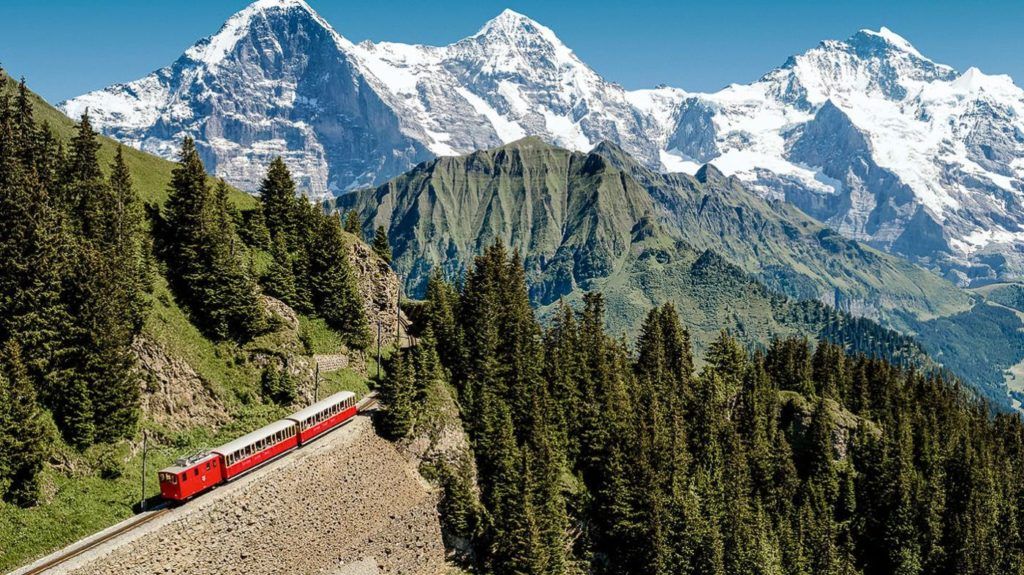
WHAT LANGUAGE WILL YOU NEED TO SPEAK IN SWITZERLAND?
In Switzerland, there are actually four official languages but the main two languages are Swiss-German and French. Depending on which region you are in will determine the languages most locals are speaking.
In the north and the east of Switzerland you can expect to hear mostly Swiss-German and around Geneva and the west you can expect to hear French. Those are the main two but in the south, there are many Italian-speaking regions, such as Lugano. The final official language is Rhaeto-Rumantsch but is spoken by a very small number within Switzerland.
So, what can you expect language-wise? Well, I spoke only a few words of German and no French, Italian, or otherwise. What I found is that there are a surprisingly high number of people in Switzerland who speak very little to no conversational English. However, there were, of course, lots of people who could speak English.
You will find that in touristy areas the prevalence of English increases and usually train conductors, tour operators, ticket booth attendants, and waiters will all know enough English to get you by.
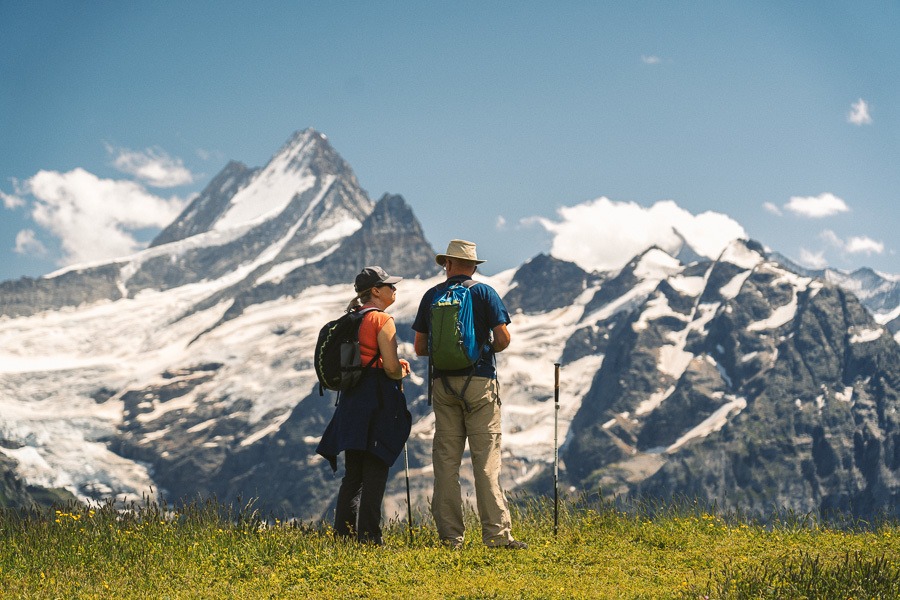
What I will say is you should try and learn a few basic phrases of German and French say you can greet people out on the hiking trails, say thank you and please at a restaurant and ask where the bathroom is. I think it is polite to learn those and any more is up to you but the more the better and locals always appreciate the effort even if your accent is horrible.
Many of the signs are in English or easy to follow, especially out on the hiking trails or at the train stations. The names of places are of course in Swiss-German or French but the directions are clear.

WHERE IS THE BEST PLACE TO BASE IN SWITZERLAND?
This is a question I can’t completely answer without knowing your budget and motives. However, I can make a few broad suggestions based on my 100-day journey around Switzerland.
If you are keen on hiking or at least viewing the mountains. I highly advise you to stay in Interlaken. I’ll go through a few key reasons that make Interlaken the best home base for your adventures.
- Price: Interlaken is relatively cheaper than most other towns. It has luxury resorts and hotels don’t get me wrong but it has more budget options than most towns. For example, in Zurich, the cheapest hostel I could find was $80 USD and in Interlaken, I stayed at a hostel for $40 USD including breakfast, two coffees per day, free locker storage, and $2 washing/drying machines.
- Location: Interlaken is a hub. If you stay in Murren, Wengen, or Lauterbrunnen you are in a great spot but you are very deep in and to get anywhere else becomes a bit of a journey. Especially if you want to go anywhere other than the Jungfrau region you are in for a long-haul trip. I was based in Interlaken for several weeks and was able to catch the train to Grindelwald in under 45 minutes, Lauterbrunnen in under an hour, and also Thun and Brienz in half an hour. You are more central and I would do things like go up to Murren at midday, do the Via Ferrata, and head home to Interlaken.
- Interlaken is quite a scenic town itself with lots to do like the Harder Kulm viewpoint, the epic Hardergrat Trail, the Schynige Platte Hike, and activities like Paragliding over the lake.

I created a couple of guides to help you investigate the best places to stay in Interlaken depending on your budget. There are a lot of budget hotels and hostels but also some traditional, stunning hotels. Here are the guides I wrote:
- Interlaken Accommodation: WHERE TO STAY IN INTERLAKEN
- Interlaken Budget Accommodation: BEST CHEAP PLACES TO STAY IN INTERLAKEN
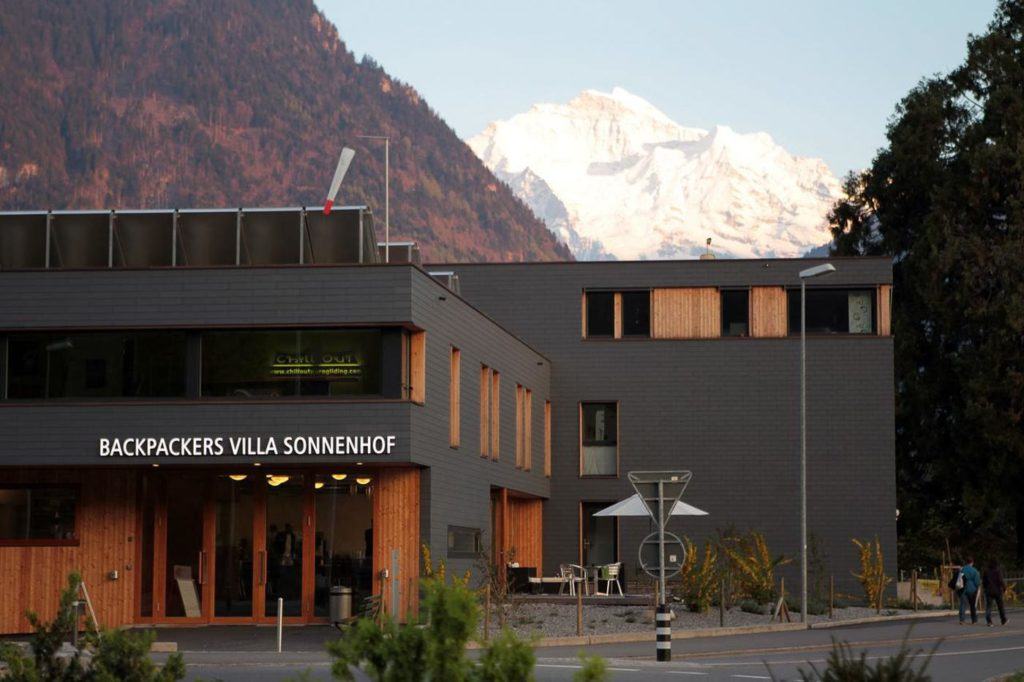
BEST TIME TO VISIT SWITZERLAND
Switzerland is quite multi-dimensional when it comes to weather and the perfect time to visit. Unlike some destinations around the world that have one amazing season that is clearly prime for that location, Switzerland is fantastic in the summer and the winter. The shoulder seasons are still okay for traveling and you can avoid tourists by opting out of the prime weather windows but it is the main winter and summer that are the popular times of the year to travel to Switzerland.
- Best time to visit to avoid crowds (shoulder season): April – June, September – October
- High Season: July – August
- Low Season: October – March
- Ski Season: December – March
- When are the Seasons: April – June (spring), July – August (summer), September – October (fall), November – March (winter)
- High Season: The high season is July to August when the weather in Switzerland is the warmest it is in the entire year, but you will have to face a lot of tourists, and an over 50% increase in prices.
- Ski Trips: Winter (between December and March) is a low season in most parts of the country, as there will be intense snowstorms. However, this is the best season for those who want to go on ski trips.

My experience With Seasons in Switzerland
I arrived in Switzerland in July and it was incredibly hot. It was great for hiking and enjoying the alpine lakes. There were big crowds in some places but there are so many hikes in Switzerland so unless you choose the most popular hike you won’t have too many people to fend off.
There were a number of cases though, where things were a bit crowded but it was never a big issue. If you try and go to Jungfraujoch and the massive tourist sites, you will be with hundreds of tourist sites in the peak season of the summer.
The summer was perfect for hiking because as you get above 2000m (which happens frequently in Switzerland), the temperature drops and it was enjoyable to not freeze to death on every trail.
As the months passed and the summer faded, the inevitable happened and I witnessed the first snow of the season. Now we had to check the snow reports and the trail reports to see if hikes were open and in a safe condition. Things became much more serious for hiking and I had to exercise more caution when hiking alone. Eventually, in August many trails and mountain huts started to close to regular hikers, so if you are looking to do hiking and are not on a crazy snow expedition, I would say get all your hiking in by August or you will be a little disappointed if things are closed.

IS SWITZERLAND SAFE?
Switzerland is one of the safest countries in the world. It has a very low crime rate, the people are quite reserved but very friendly and will help if you ask. Never did I feel unsafe and I spoke to a number of solo female travelers who also felt safe out hiking and in the towns.
There was a good vibe at the hostels and things were organized quite well. I can’t really imagine how Switzerland could be safer. There is internet connection throughout the country so you can stay in touch, which is an important safety factor also.
The most unsafe part about Switzerland is that it is so adventurous that many people go a bit far out of their comfort zone. It’s important to remember that what is comfortable for locals who grew up with mountain experience is not necessarily suitable for a city kid who is on their second hiking vacation. Play within your limits especially if alone on a trail.


HOW DOES IT WORK HIKING TO MOUNTAIN HUTS
While you are hiking in Switzerland, it is inevitable you will come across some incredible mountain huts. I didn’t know much about the hut culture in Switzerland but once I was in on it, I loved it. Basically, the mountain huts are kind of like mountain cabin hotels. They usually have a restaurant and also a number of dormitory-style rooms.
For average-sized huts, it is common for a family to live up in the hut on the mountain during the summer and hiking season and visitors can book a night or more up at the hut. When they arrive they have dinner and breakfast included in their nightly fee. I stayed overnight at five different huts (which were listed above) and most ranged from about $60 a night to $100 a night per person including breakfast and dinner.
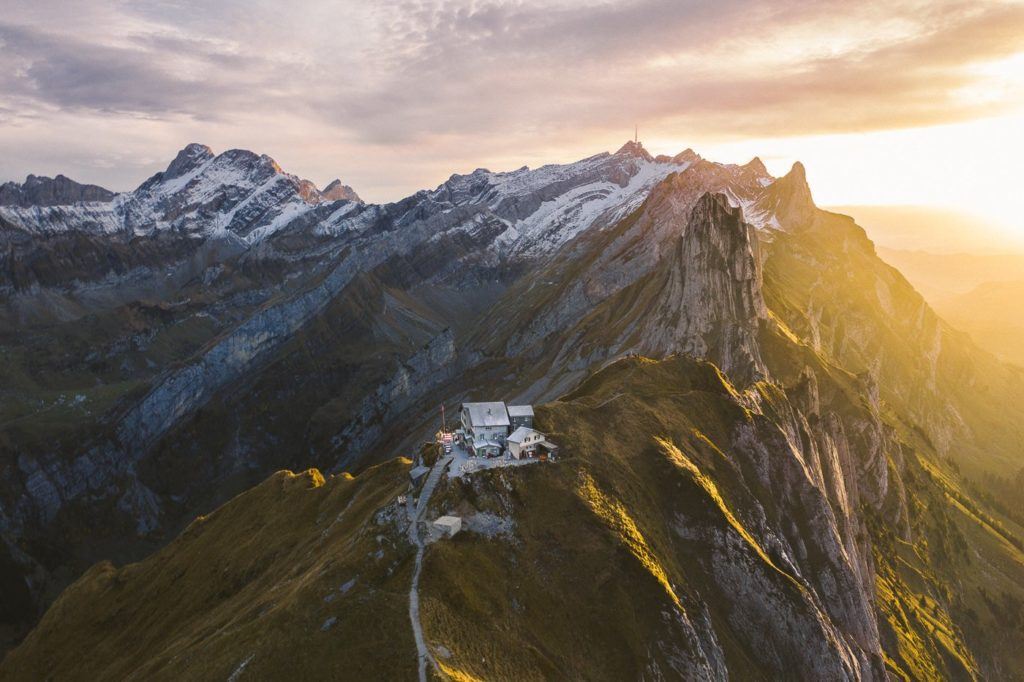
The ‘huts’ are actually pretty fancy and have heating, nice restaurants, balcony, alcohol, games, books, and much more. All you need to bring is a sleeping bag liner and your hiking gear and you are set. You can also shower at most of the huts (usually included in the price also).
I always did a one-night stay so I would hike up, watch the sunset and stay the night. I would then hike at sunrise and explore further on before hiking back down.
Many hikers like to do hut-to-hut mountain hiking, which means you map out several huts that are within hiking distance of each other and you do a multi-day trek where each night you will make it to a new mountain hut on the connecting trails throughout the Swiss Alps. It’s a great way to hike because you don’t need to carry all of your food, heavy camping gear, or warmer clothes for the cold nights outside. You do all your eating at the hut restaurants and carry a few snacks with you and sleep in the comfort of the cabin dormitories. If you are in Switzerland in the summer, I can’t recommend it enough.
You can click on one of the following links to visit my blog post about the mountain huts I visited. I stayed at Gleckstein Hut, Trift Hut, Ebenalp Hut, Baregg Hut and visited many others while passing through on hikes in Switzerland.

The other key point to remember is that most meals in Switzerland are $20-$40 at least so when you consider you are getting two meals included, the accommodation is really only $30-40 per night, which will be the cheapest accommodation you find in Switzerland but the best view!
If you are planning to stay at a lot of mountain huts you can buy a Swiss Alpine Club (SAC) membership, which also involves a rescue service if you get stuck on the mountain. This membership gives you a discount of usually 40-50% off the regular price of the hut price. It costs about $80 USD for the yearly membership so after three overnight stays you have made your money back and you are supporting the mountain hut owners of Switzerland, who you will see are all really nice families.

CAN YOU DRINK THE TAP WATER?
The tap water was one of my favorite parts of Switzerland. After traveling through Asia for many years, I was used to the constant battle to find safe drinking water without buying wasteful plastic bottles. In Switzerland, the water is 100% safe to drink from taps in buildings and it even goes one step further.
Most towns and even trails have fountains and taps installed (often very intricate and beautiful fountains) and you can fill your bottle up straight from the fountain. With so many glaciers and alpine regions, there is no shortage of fresh, clean water in Switzerland. I always carry a Hydroflask with me and keep it full all the time so I can stay hydrated and save money on buying drinks.

A UNIVERSAL TRAVEL ADAPTOR WILL DO THE JOB
In Switzerland, the adaptor you will need is for TYPE J outlets compared to the rest of Europe that uses Type F. To avoid all the confusion of plugs, it’s best to get a universal adaptor that works for any device in any country outlet. I’ve had one for two years and it wasn’t expensive at all and takes the hassle and stress out of figuring out the outlets and plug types of each country. Importantly it means you don’t need to carry lots of adaptors and plugs for every country, just one that fits them all. I’ll link the one I’ve used for two years here: Universal Travel Adaptor
ESSENTIAL HIKING GEAR FOR SWITZERLAND
Hiking in Switzerland is very different in the summer to the winter, which will obviously make a huge impact on what type of clothes and gear are necessary. However, for this little section on essential gear, I will just point out a few key items that you should have for basic hiking in average conditions. You’ll need hiking boots or trail running shoes, beanies, hiking socks, and more but I’ll write a more detailed post about that another time. This is just a quick round-up of three essentials but for a full rundown of all the hiking gear and camera gear I use you can check out this post: MY TRAVEL PHOTOGRAPHY GEAR: WHAT’S IN MY BACKPACK
- Hiking Poles: Not everyone will use them but the Swiss are religious about them, unlike many Australians or Americans. You will learn to love them too as they take the strain off your knees and quads on both the uphill and the downhill. I used them to power up hills and help as a shock absorber on the way down. You can get them quite cheap but I found that there were two components to my hiking poles that I really liked. They were foldable down to a small size so I can put them in my backpack side pocket and they were the carbon fiber/lightweight style. They are a bit more expensive but I used them a lot and they became a necessity in the end. I’ll link you here to the carbon-fiber LEKI foldable hiking poles that I bought. I purchased them in Switzerland so they were very expensive but you can get them online much cheaper. My Hiking Poles: Leki Micro Vario Carbon Fiber Hiking Poles

- Down Jacket: The next key item to have is a down jacket. Even in the summer when it might be hot at lower altitudes, once you reach the summit it gets that much colder. If it’s a sunrise or a sunset, I always had a lightweight but very warm down jacket with me. I chose one that I could stuff into my backpack when it was too hot but could always afford to carry it size-wise in case it was colder than I expected and I used it too many times to count. I’ll link you here to the Patagonia lightweight down-jacket that I bought online before heading to Switzerland. My Down-Jacket: Patagonia Nano Puff Jacket
- Hiking Gloves: They might seem like a small item but your hands are the first things to go when it gets cold. They don’t have to be amazing gloves but you want something. I chose gloves that still let me operate my camera and phone but had a decent amount of warmth too. Once you start doing sub-zero hikes in Switzerland, you will want a more heavy-duty type of glove. I’ll link here to the gloves I used in Switzerland that let me still operate my camera. My Hiking Gloves: North Face E-tip Gloves

YOU ALWAYS NEED A TICKET
There are many countries around the world where you might be able to get away with little hacks or find ways to cheat the system. In Switzerland, the system is so efficient that you shouldn’t bother. When we found the prices of the train so high, of course, it crossed our mind whether we should risk it and not buy a ticket at all. We still bought the ticket and quickly found out then on most major routes the tickets were checked by the staff who walk up and down the train.
It is very expensive to ride the trains but don’t try and outsmart the system as it is just too efficient. If you get caught on the train without a ticket it is a $99 USD equivalent fine plus the cost of the far you were taking so it’s not worth the risk. Of course, you should have high morals and never even consider this but when you purchase a train ticket for $100+, everyone begins to question their morals!
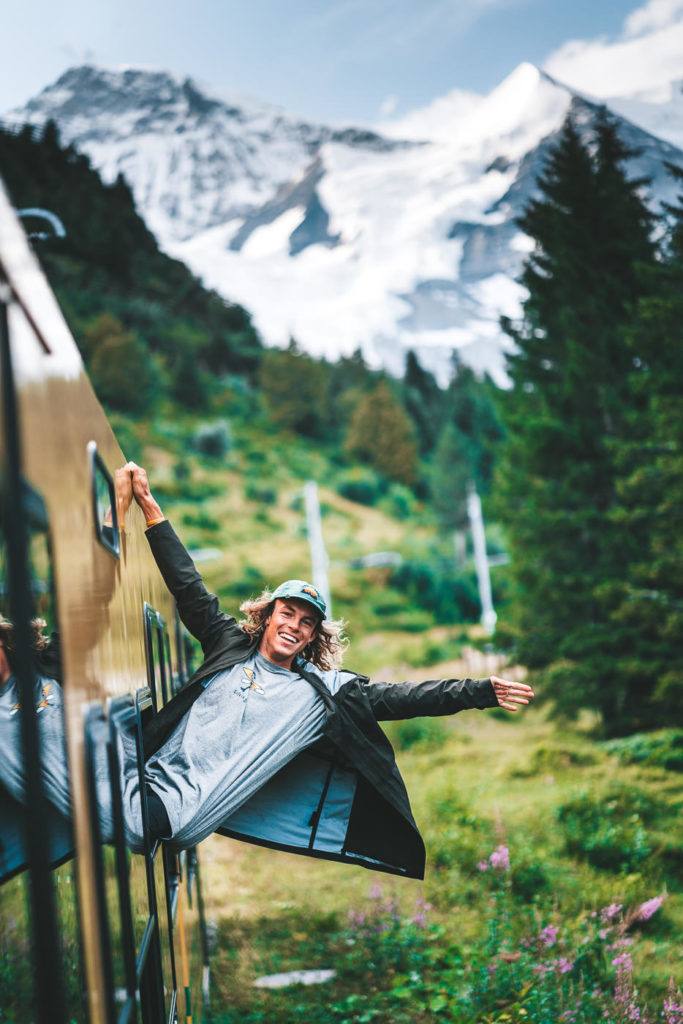
RED AND BLUE TRAIL MARKERS
Red and white markers on the trail mean it is a Swiss walking trail and you won’t need any expertise in climbing. It doesn’t mean it’s easy though as it could be 20 kilometers of hiking trails with 2000m of consistent incline but it won’t be technical so you will still need to look into the hike first to know what you are up against. Blue and white markers will be painted when they are indicating a technical or alpine route. Sometimes they are still quite tame but again, this is a warning sign that it is not going to be a leisurely walk on a trail and you can expect some kind of rock scrambling or climbing to be involved.
Swiss locals have years of experience on the trails so never compare yourself to a local and assume you can do it. I saw some local children on hikes that were far more experienced than me so you are better off comparing yourself to your previous efforts when deciding if you can take a certain route or make a certain climb.



YOU HAVE TO TRY A VIA FERRATA
For those who don’t know what a Via Ferrata is, it’s basically a series of ladders, steps, and rock climbing that leads you up a wall. You are wearing a harness and clip into a strong wire at the start of the Via Ferrata. From that point, you are always clipped in with at least one clip.
Every 10 steps or so, you reach a new section of wire and you unclip one Carabiner clip from the old section and attach it to the new section. Once it is firmly secured, you unclip the second clip from the old section and also add it to the new section so you now have two Carabiner clips in the new section and you move another ten steps.
I had never heard of it before Switzerland but it fast became one of my favorite activities. I did four Via Ferrata courses across Switzerland and they were definitely a highlight of my trip.
You can click any of the links for the places I did a Via Ferrata in so you can check out those specific blogs. My Favorite Via Ferrata experiences were: Murren to Gimmelwald Via Ferrata, Furenalp Via Ferrata, Rotstock Via Ferrata, and Pinut Via Ferrata.


CHECK THE SUMMIT CONDITIONS BEFORE YOU HIKE
Many trails and summits in Switzerland have a webcam at the top. This isn’t to ruin the surprise of the view for yourself but to check the weather. Remember in some cases you may be at accommodation several thousand meters below the summit you are hiking up so there can be a big difference and you may want to check that there isn’t a huge layer of fog and maybe wait for a more appropriate day.
I used the webcams as a guide but sometimes the weather can change quickly. Simply search webcam+name of hike and you will find if there is one. One site that has many of them is Bergfex, which I used regularly.
If you have multiple days to plan your activities, why not give yourself the best shot of not getting rained on or the greatest opportunity to ‘get lucky’ with a beautiful sunrise or sunset? Once you start planning by the weather forecast, you will realize that luck plays a smaller part than you think. I only found out about the Switzerland travel tip after a few weeks in the country but then used it to plan my hikes for certain days when I could get the best weather and photos.

FREE OUTDOOR GYMS IN SWITZERLAND
Switzerland is one of the most expensive countries in the world so you would expect working out to cost you an arm and a leg also. However, we found out that there are lots of outdoor gym courses hidden in the forests of Switzerland. It’s a bit strange but pretty cool when you see the locals actually using them.
Basically, there’s an app and a website called Zurich Vita Parcours and you can just search your location and find the nearby outdoor gyms. They are often set up at several stations in a little forest course so you have to walk or jog between them. Josh and I found lots throughout our trip and they were really well equipped and kept us in shape. This is one of my top tips for traveling in Switzerland, especially if you are there for an extended period of time


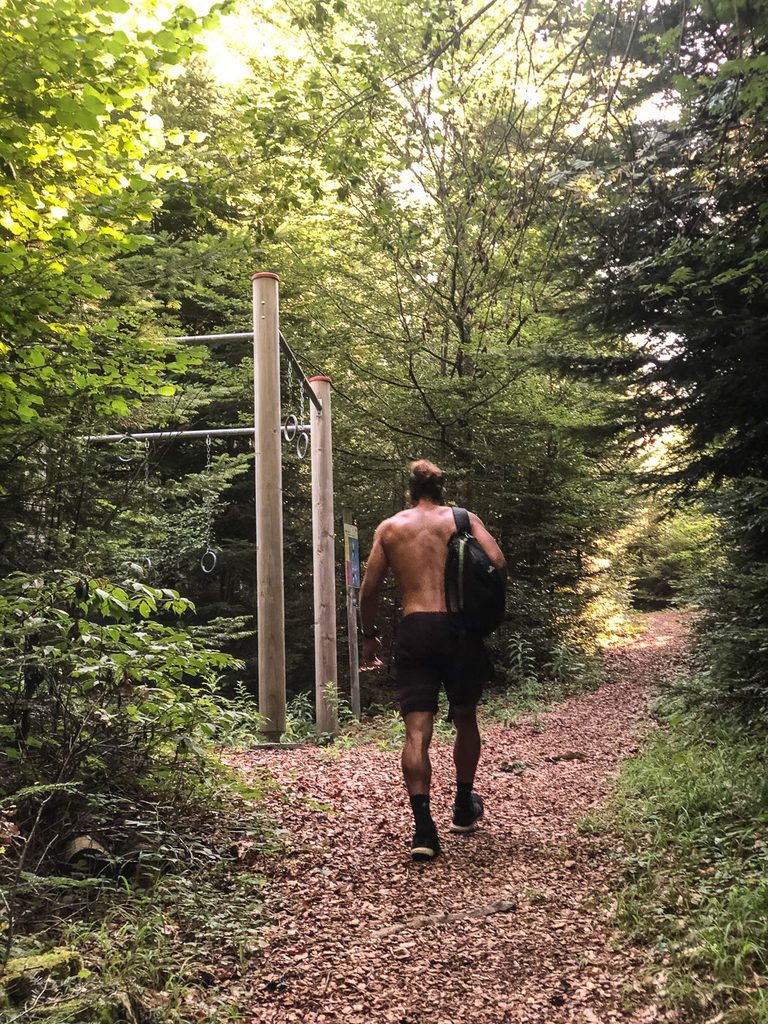
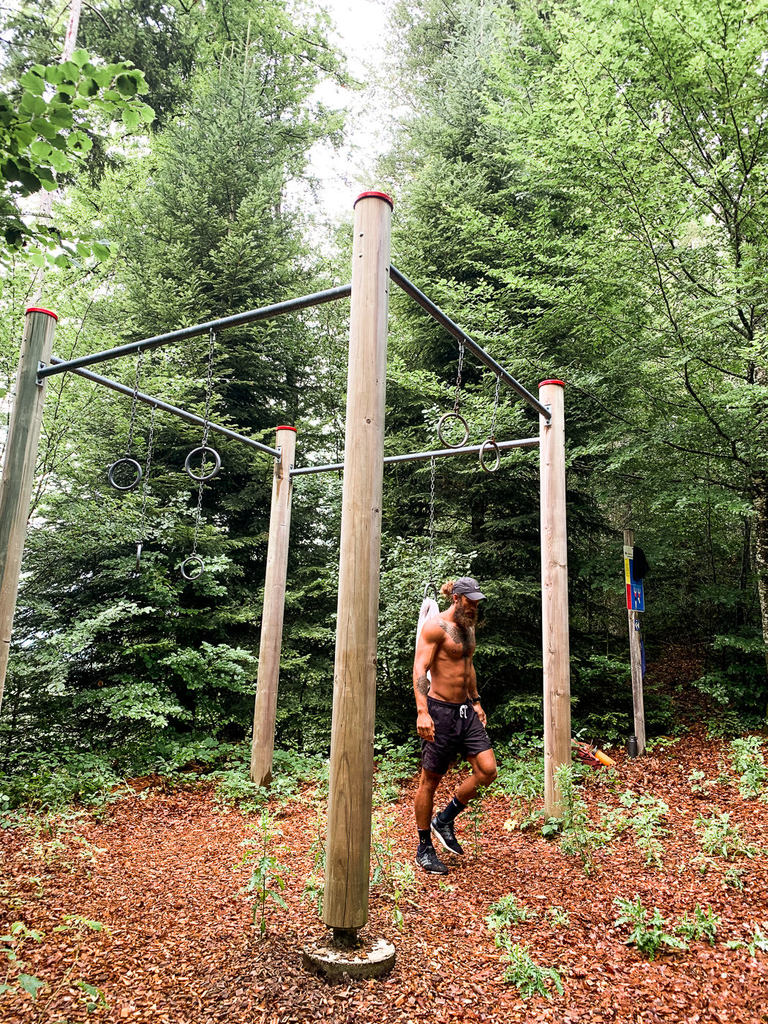
SAC HIKING SCALE -DIFFICULTY RATING GUIDE
Switzerland has a SAC difficulty scale, which labels hikes with a technical score such as T2 or T5 etc. All of the hikes in this blog post are T4 with a few T5 exceptions. I have included the full table/difficulty scale below so you can see what level suits you and the explanation of each level.
Below you can see the Swiss Alpine Club (SAC) difficulty rating scale I mentioned earlier in the article. Each level from T1 to T6 is explained in detail so you can understand what to expect when you see that terminology during your time in Switzerland.
- T1: Hiking – Well-developed and marked paths, mostly flat or slightly inclined, suitable for walking in trainers, navigation without a map possible.
- T2: Mountain hiking – Continuous route marking, some steep sections with a risk of falling, trekking shoes recommended, basic navigation skills required.
- T3: Challenging mountain hiking – Footpath available, partially exposed areas with ropes or chains, steep terrain and danger of falling, good trekking shoes and average navigation skills needed.
- T4: Alpine walking – No guaranteed path, sometimes requires the use of hands, exposed with various terrains including grass heaps, rocky slopes, and snow-covered areas, stable trekking shoes, terrain assessment, and good navigation skills necessary.
- T5: Challenging Alpine walking – Often without a path, includes simple climbing sections, exposed and challenging terrain with steep slopes and snow-covered areas, requires mountaineering boots, excellent navigation skills, proven alpine experience, and familiarity with alpine equipment.

MAPS IN SWITZERLAND
used Google Maps for getting around Switzerland and planning my train transits, which is important to see when the last train is, which connection you need to make, and what the quickest route is. You can also use the SBB app, which is even more accurate than Google Maps but I still prefer Google Maps as it includes any walking or a more broad scope of getting around. The SBB app is the official transport app of Switzerland and you can use it to get cheap, non-peak-time train tickets and it has all of the scheduling and official information about transit in Switzerland.

START SMALL AND EASE YOUR WAY INTO IT
If you are a city dweller or into moderate outdoor activity only, this applies to you. However, even if you are quite athletic you should still listen up. Switzerland is not your average adventure. A tough hike from where I’m from in South Australia is 400m of incline and 10km return. In Switzerland that might be considered a warm-up.
This is a country that thrives in the mountains so make sure you don’t bite off more than you can chew on your first few trails. Pick a couple of hikes that are good for beginners. Don’t let your ego lead you astray thinking you are well above a beginner hike because a Swiss beginner hike is relative to a regular or tough hike in other parts of the world.
Try and stick to hikes under 10km in distance and with no more than 600m of incline for your first couple. If you are finding them too easy then start looking at 1000m+ vertical hikes and longer distances or multi-day hikes.

CABLE CARS IN SWITZERLAND: WHAT YOU NEED TO KNOW
The cable cars in Switzerland are great. If it’s a big hike, you can either catch one up to the summit and hike down, or hike up and catch the cable car down. If you aren’t interested in hiking just catch one up and down. It makes the mountains accessible to all types of hiking and adventure abilities.
I think this is one of the top things to know before traveling to Switzerland so that you understand you don’t need to be an expert hiker to enjoy the awesome views.
Many cable cars are not covered by the Swiss Half-Fare Pass or the Swiss Travel Pass or some may give you a small discount. I found this a bit strange when the Swiss Travel Pass is more than $100 a day and it still didn’t include all cable cars but it’s because many cable cars are privately owned and run and not part of the Swiss transport system like the trains and buses.
Cable cars can range from $8 to $60 depending on the journey with some of them taking you several kilometers. It can add up quickly and you can save yourself a lot by hiking down from summits.
GET A SWISS TRAVEL PASS!
Enjoy UNLIMITED train, boat, and bus rides in Switzerland for up to 15 days. Click to book a flex Swiss Travel Pass or choose the Consecutive Swiss Travel Pass.
The Swiss Travel Pass starts at $260 for 3 days. Click here to check if it’s available on your travel dates.
It’s important to note that the cable cars often stop running well before sunset and not early enough for sunrise. This means if you want to see the golden hour, you will need to get your hiking boots on and your head torch ready. We did this many times and it was always worth it but always a pretty wild adventure in the dark. Make sure you check the timetable of the cable car so you know when the last ride down is to be sure you are safe.

SUNRISE & SUNSET SPECIAL CABLE CARS
I did say above that the cable cars don’t run during sunset and sunrise most commonly. However, there are a few special services that happen several times a month or on special occasions that specifically cater to those who want to watch the sunset or sunrise at the summit.
I was lucky enough to hear about two of these services and made the most of one while the other was too expensive. There is a sunrise train to the Riffelsee in Zermatt. Here you can see the reflection of the Matterhorn in the lake at sunrise. That ticket cost $100 USD and included breakfast at the top of the Gornergrat. I thought that was a bit much and hiked up by myself.
The second was the ‘late’ cable car at Mount Niesen near Interlaken. At Mount Niesen, there is a beautiful restaurant, and several times a month in the summer they run cable cars all the way until 10 pm so that diners can enjoy the sunset. There is no massive fee like at the Riffelsee Rail in Zermatt, the regular Niesen cable car just runs later so it isn’t expensive.
I hiked up, watched the sunset, and then caught the cable car down at 9 pm after enjoying soup at the restaurant after sunset. Definitely ask around and try and plan these into your trip because sunrise or sunset at a summit in Switzerland is worth the planning and effort. This is a Switzerland travel trip I wish I had heard about earlier in my three-month stay!
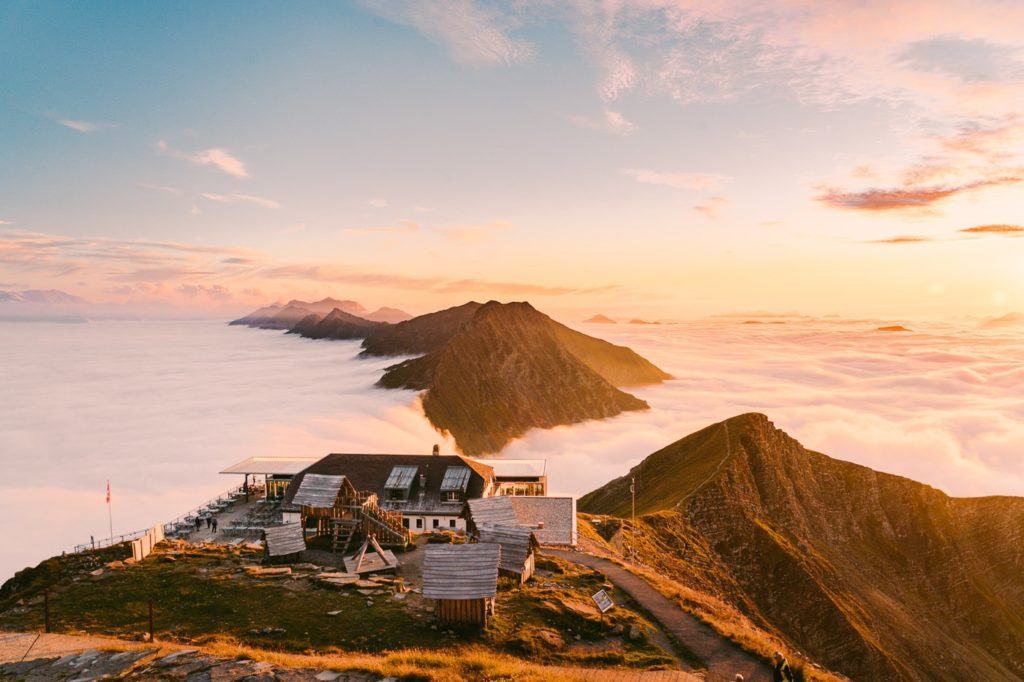
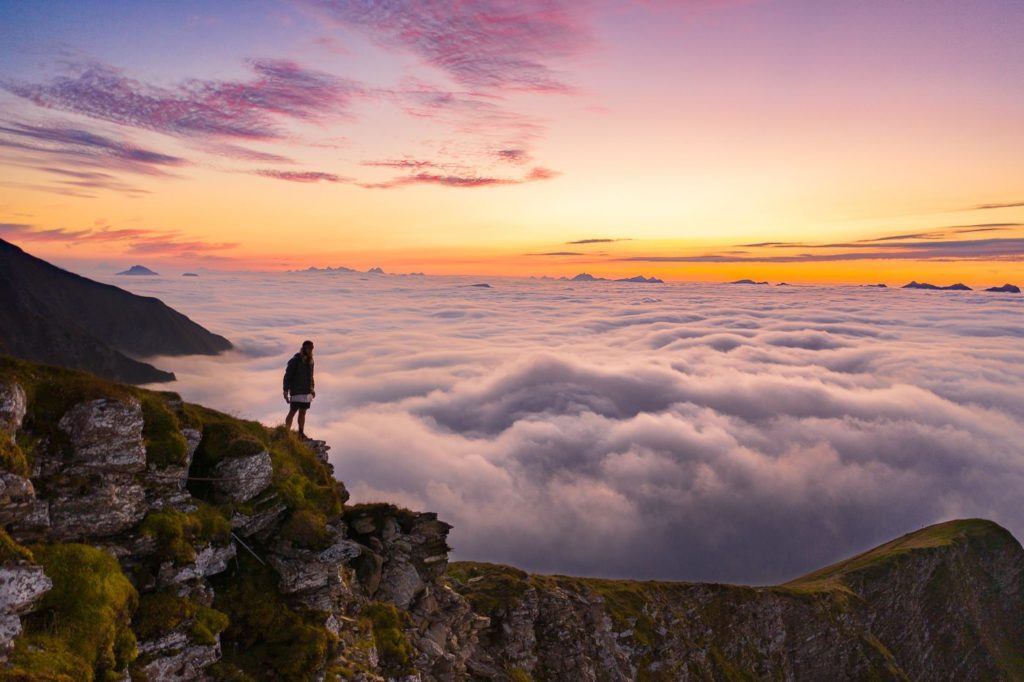
THE BEST VALUE FOOD IN SWITZERLAND
I’ve established by now that Switzerland is very expensive so, of course, the food is right up there with things you probably can’t afford while on your Swiss tour. Meals can cost upwards of $30 and eating at restaurants just isn’t an option for many travelers who frequent the grocery store and smaller cafes.
However, if you don’t find yourself at a restaurant or mountain hut go for the soup and ask for extra bread. Here are a few reasons why soup is always the best option:
- The soups throughout Switzerland are amazing and they are a bit of a specialty with a unique recipe at every mountain hut or cute restaurant.
- Soup is usually half the price of any meal but when the free side of the bread is added in, it’s usually just as filling.
- It will warm you up on a chilly adventure.
- You can usually ask for an extra bit of bread and for just $8-12 you have filled yourself up instead of a $25+ pasta or regular meal.

Those are my top Switzerland Travel Tips and I hope they help you have a smooth trip through Switzerland. I’m sure you’ll learn lots more helpful travel hacks and Swiss travel tips as you go so do let me know in the comments if you think there are any more tips that I should add to this list!
MY SWITZERLAND HIKING GUIDES
I spent 100 days hiking in Switzerland and created a guide for different regions around the country. You can click on one of my Switzerland hiking guides below to help you plan your trip.
- The Complete Guide: 50 AWESOME HIKES IN IN SWITZERLAND
- The Via Ferrata Guide: 4 EPIC SWITZERLAND VIA FERRATA COURSES
- Lauterbrunnen Guide: 10 AWESOME HIKES NEAR LAUTERBRUNNEN
- Interlaken Guide: 15 AWESOME HIKES IN INTERLAKEN
- Grindelwald Guide: 12 AWESOME HIKES NEAR GRINDELWALD:
- Mürren Guide: 7 AWESOME HIKES IN MURREN
- Appenzell Guide: 9 AWESOME HIKES NEAR APPENZELL
- Chur Guide: 7 AWESOME HIKES NEAR CHUR

MY SWITZERLAND TRAVEL TIPS
- For Backpackers: SWITZERLAND BUDGET BACKPACKING GUIDE
- Travel Tips: 20 THINGS TO KNOW BEFORE VISITING SWITZERLAND
- Transport Tips: RENTING AND DRIVING A CAR IN SWITZERLAND
- Accommodation Guide: 30 BEST PLACES TO STAY IN SWITZERLAND





William Henry
Tuesday 18th of July 2023
Thank you so much for lv bunny cream varsity jacket sharing such a great and knowledgeable blog. Thanks!
Tracy
Wednesday 22nd of February 2023
Love all the details you provide like technical epertise needed/optional routes, etc. Also love the pictures. All of this is so helpful in planning our upcoming trip.
Adam
Sunday 8th of May 2022
Thanks for this detailed review. I would also add that it is also important to have a vaccination now or a covid test. Websites like https://personichealthcare.com/ can help you get it done quickly. This is essential for a safe and easy trip to Switzerland
Emma
Saturday 16th of October 2021
Thanks for the armchair travel experience to one of my favourite countries during this time of limited travel. An important thing to know is that many gondolas and funiculars can be closed for maintenance a couple of times a year. Usually this happens after each high season. Of course being Swiss, they will have that information posted well in advance so you can plan around it. Here is a website that lists some of the most popular oneshttps://holidaystoswitzerland.com/cable-car-and-funicular-closures-winter/ When I went hiking in Switzerland and was passing through one of the more main train stations, I would stop at a Migros Take-Away and grab one of their delicious sandwiches to eat on my hike. Or pop into a mini-sized Migros or Coop grocery stores conveniently located in the train stations and purchase my trail meal there (Swiss chocolate anyone?)
Mark
Sunday 29th of August 2021
I bought a Lonely Planet guide and, given that hiking is a primary activity in Switzerland, was shocked to find that the info they had was paltry. I ran across your blog, which is an absolute goldmine and the best info I found scanning the internet today. I returned my Lonely Planet guide.
I'm planning to go in October, but worried about paths not being open. I'm fine with day hikes since it sounds like huts won't be open, but you mentioned trails might be closed too? Just because of snow or more officially? What are your thoughts on going in the first week of October? Am I better off just waiting for another time of year?
Jackson
Sunday 29th of August 2021
Hi Mark,
While every year the weather changes, I was in Switzerland til October 25 on my visit. There may be some routes closed but the first few weeks of October should have a decent number open. It depends on when the first snowfall is in that particular region. Many of the lower elevation trails may well be open.
Regards,
Jackson